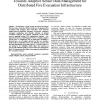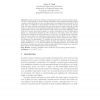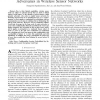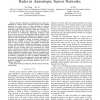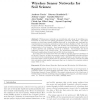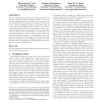PERCOM
2010
ACM
13 years 10 months ago
2010
ACM
Abstract—Becoming proficient in a sport requires significant investment in training. Wearable sensor devices can improve training due to the high level of mobility, ubiquity and...
PERCOM
2010
ACM
13 years 10 months ago
2010
ACM
—This paper presents a Secure Code Update (SCU) system for Wireless Sensor Networks (WSNs). This solution achieves different security goals. First, through a dedicated authentica...
MDM
2010
Springer
13 years 10 months ago
2010
Springer
— We introduce a novel strategy for data processing in Wireless Sensor Networks (WSNs) in the case of emergency fire evacuation with stringent delay constraints. Such networks sh...
JUCS
2010
13 years 10 months ago
2010
Abstract: Most of ambient intelligence studies have tried to employ inductive methods (e.g., data mining) to discover useful information and patterns from data streams on sensor ne...
JSAC
2010
13 years 10 months ago
2010
—Due to their limited capabilities, wireless sensor nodes are subject to physical attacks that are hard to defend against. In this paper, we first identify a typical attacker, c...
INFOCOM
2010
IEEE
13 years 10 months ago
2010
IEEE
Abstract—Distance estimation is fundamental for many functionalities of wireless sensor networks and has been studied intensively in recent years. A critical challenge in distanc...
INFOCOM
2010
IEEE
13 years 10 months ago
2010
IEEE
— Self-monitoring the sensor statuses such as liveness, node density and residue energy is critical for maintaining the normal operation of the sensor network. When building the ...
INFOCOM
2010
IEEE
13 years 10 months ago
2010
IEEE
Abstract—Wireless sensor networks (WSNs) are typically composed of low-cost sensors that are deeply integrated with physical environments. As a result, the sensing performance of...
IJSNET
2010
13 years 10 months ago
2010
Abstract: Wireless sensor networks can revolutionize soil ecology by providing measurements at temporal and spatial granularities previously impossible. This paper presents our fi...
DMSN
2010
ACM
13 years 10 months ago
2010
ACM
E-science applications use fine grained data provenance to maintain the reproducibility of scientific results, i.e., for each processed data tuple, the source data used to proce...

